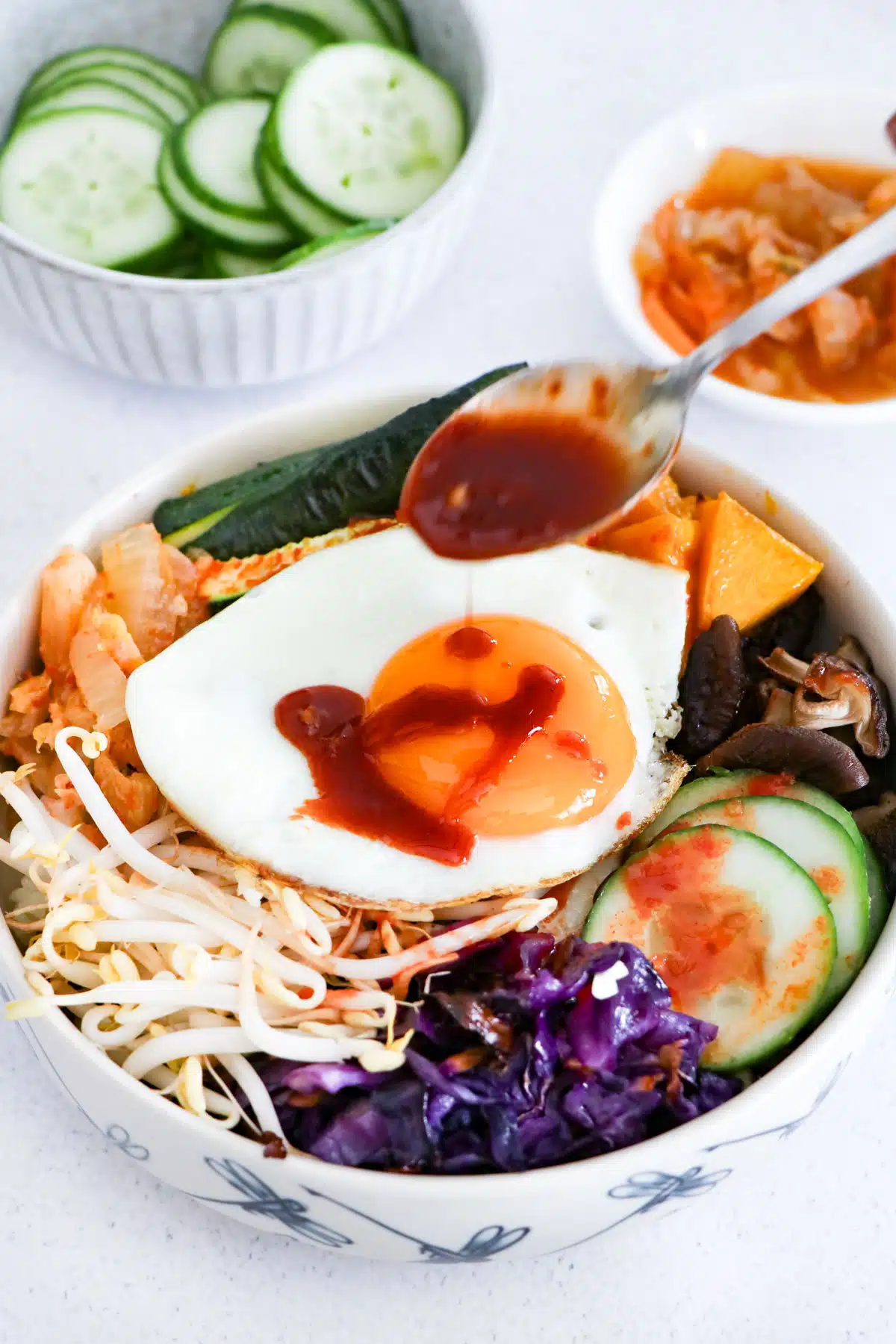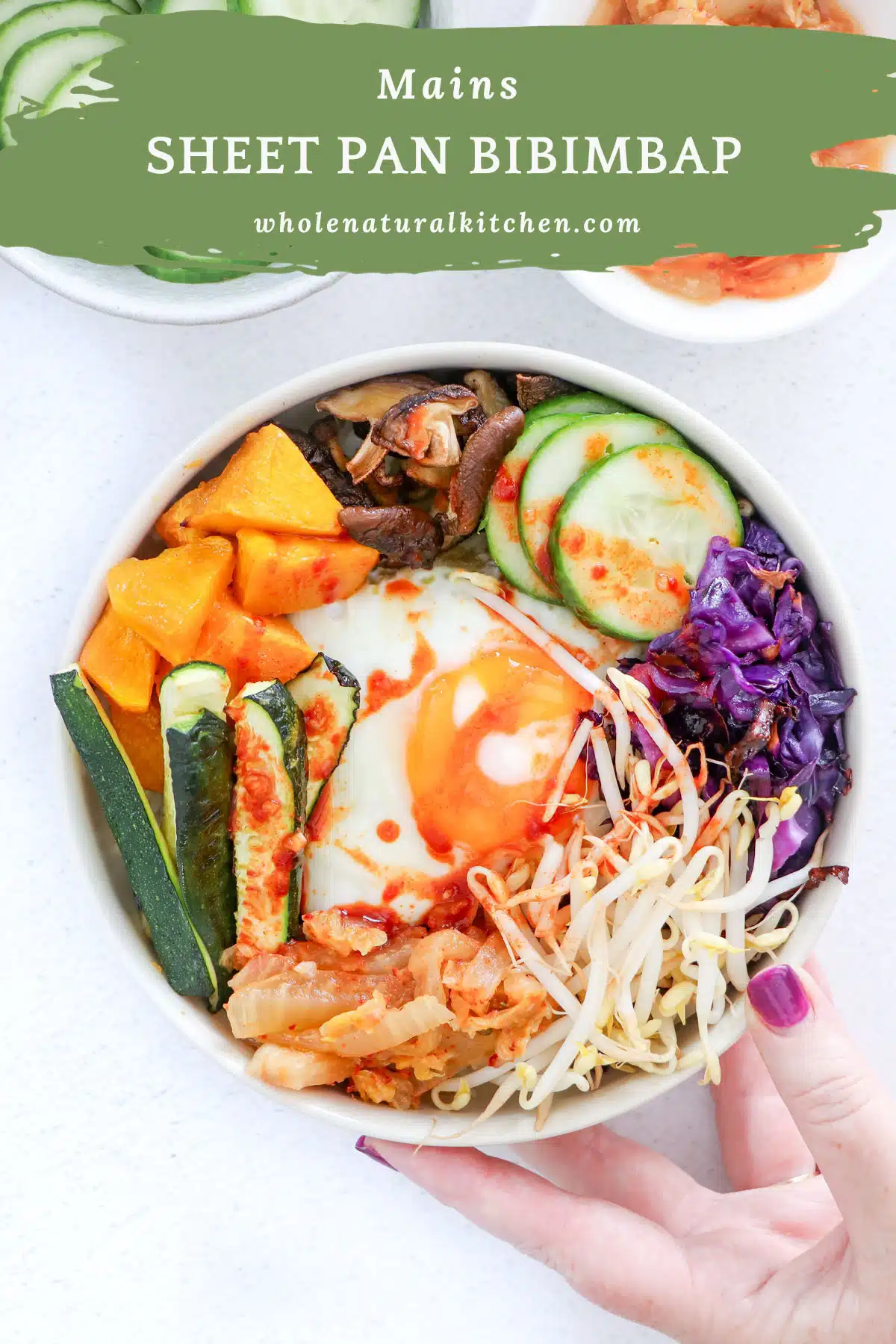Sheet Pan Bibimbap
Sheet Pan Bibimbap is a simplified version of this classic Korean dish that’s loved the world over. It boasts an array of colours and textures and is bursting with savoury and spicy goodness. It’s also a quick and easy meal making it perfect for weeknight dinners.

In This Article
What Makes This Recipe So Good?
Bibimbap is a wonderfully nutritious and well-balanced dish with its combination of vegetables, protein, and grains. And if you struggle to meet your daily vegetable servings it’s a great meal for you! A big bowl of bibimbap ensures a good amount of colourful veg are being consumed, which comes with the added benefit of contributing a wealth of vitamins, minerals, and antioxidants to your meal. Additionally, the inclusion of healthy fats along with pre and probiotic-rich elements like sesame oil and kimchi (if used) contribute to good gut health. And so does the fibre in the veg of course.
If, like me, you’re interested in the origins of a dish, bibimbap has a fascinating history, which you can read more about in this article.
Ingredients – What You Need To Make This Recipe
Seasonal vegetables, leftover rice, and the classic Bibimbap sauce combine to make a filling and nourishing meal. While gochujang is easy to come by in most supermarkets, I suggest looking for a good quality version at an Asian grocery store.

- Leftover cooked rice – this forms the basis of bibimbap bowls. If you don’t have leftovers on hand though just get a pot on to cook while you prep the vegetables.
- Mixed vegetables – shiitake mushrooms, zucchini, red cabbage, and pumpkin were used in this recipe and contribute both earthy and sweet flavours in addition to providing a textural contrast to the dish. Shiitake mushrooms offer a rich umami depth, while zucchini, cabbage and pumpkin add sweetness and tenderness.
- Bean sprouts – offer a refreshing crunch to the bibimbap to balance out the stronger flavours.
- Pickled Cucumber – also adds crispness and a bit of zing.
- Salt – helps to bring out the natural flavours of the various components and balance the dish’s overall taste.
- Gochujang – This Korean red pepper paste is the heart of the bibimbap sauce, adding a spicy, savoury, and slightly sweet flavour.
- Toasted sesame oil – imparts a rich, nutty aroma and flavour. It contributes depth and a hint of smokiness to the bibimbap.
- Rice vinegar – contributes a refreshing acidity that balances the bibimbap sauce’s spiciness.
- Maple syrup – adds a sweet complexity while mellowing the overall flavour of the sauce.
- Garlic – adds a pungent and aromatic kick to the sauce.
Pickled red onion or kimchi, and a drizzle of soy sauce, tamari or coconut aminos are other great additions to consider when serving.

How To Make This Sheet Pan Bibimbap Recipe Step By Step
This bibimbap recipe is very much inspired by Eric Kim’s version, which I came across a couple of years ago in the New York Times. It’s the ultimate quick and easy meal and is a great way to use up any leftover rice too.
For The Bibimbap Sauce
- Combine the gochujang, rice vinegar, maple syrup, garlic and sesame oil in a small bowl. Mix well to combine and set aside.

This will be used to spoon over each bowl of piping hot rice, vegetables and egg right before serving. Making it first means your meal won’t get cold!
For The Pickled Cucumber (Optional)
- Place the sliced cucumber, 1 tablespoon of rice vinegar, ¼ teaspoon of toasted sesame oil and a pinch of salt into a small bowl and toss gently to combine. Set aside.

To Make The Bibimbap




- Preheat the oven to 356ºF/180ºC.
- Place a large sheet pan on the bottom rack of the oven to heat through. This will be used to reheat the rice later.
- Chop the pumpkin, then slice the zucchini, mushrooms and red cabbage and place into separate sections on another large baking sheet. Drizzle with olive oil, sprinkle with salt (try this mushroom salt recipe!) then toss each vegetable in its own section to coat.
- Place the tray on the top rack of the oven and bake for 20 minutes.
- At the 20-minute mark, remove the empty preheated pan from the oven. Working quickly – drizzle another 2 tablespoons of olive oil over the pan then spread the rice out. Flatten it out so plenty of surface area is exposed to the heat. Transfer back to the bottom shelf of the oven and bake for 4 minutes or until completely heated through.
- While the veg and rice finish baking. Heat a large frying pan over medium heat. Add in the final tablespoon of olive oil and fry four eggs sunny side up (or to your liking).
- To serve, add the rice to four bowls, and top with a fried egg, then some of each vegetable (again keeping them in their own sections) along with a small handful of bean sprouts, the cucumber and kimchi if using. Drizzle over the bibimbap sauce and remember to mix it all together before digging in!

Substitutions And Variations
The types of vegetables used in this recipe can be changed to suit the season you’re in or what’s in your fridge. Things like sweet potatoes, green beans, carrots, bell peppers (capsicum) or other varieties of mushrooms also work really well.
Replace the fried egg in each bowl with a baked egg if you’d like to make the whole thing in the oven. To do this ensure the sheet tray you place on the bottom rack at the start of the recipe is one with a rim so the eggs don’t slide off before they make it to the oven! Follow the recipe to step 5, then after pouring oil, spread the rice over one half of the pan and crack the eggs over the other half. Continue on with the recipe.
If you’d prefer to have freshly cooked rice or you simply don’t have any leftovers, you can make some on the stove or in the instant pot while the vegetables are baking. Instant pot is my favourite method and to do this – add 1.5 cups of washed, medium-grain rice to the instant pot then add 1.5 cups of chicken/vegetable stock or water. Select manual/high pressure for 3 minutes. Let the pressure release manually for 10 minutes, then quickly release the remaining pressure. Remove the lid, fluff the rice with a fork then serve into bowls and top with the remaining Bibimbap ingredients.
White rice is traditionally used for bibimbap but you can substitute it with brown rice if that’s what you have.
Expert Hints And Tips
The one ingredient you may not have in your pantry for this recipe is gochujang. I recommend buying this product from an Asian grocer because you’ll find one of much higher quality with better ingredients than those in general supermarkets. The latter tend to have a very high volume of high fructose corn syrup in them and may not be gluten-free if that’s a concern for you.
If you want to skip on making the sauce altogether there are many pre-made bibimbap sauces on the market. O’Food is a great brand I’ve seen to date (not sponsored).
Storing/Freezing/Make Ahead
Leftover rice should not be reheated more than once. As such, only the vegetables and sauce can be stored should you find yourself with an excess.

Storing
Any leftover vegetables can be stored in an airtight container in the fridge for 2 – 3 days.
The sauce can be kept in a jar in the fridge for up to a week.
FAQs
Yes! Bibimbap is a well-balanced meal with the inclusion of protein, grain and vegetables. If adding the kimchi you also have a probiotic element to the dish.
The dish is served in separate sections for presentation but should be mixed together before eating. That way you’ll get a bit of everything with every mouthful.
Other Delicious Mains To Try
If you try this recipe, I’d love to know. Leave a comment, rate it, and remember to tag @wholenaturalkitchen in your pics or reels on Instagram, Facebook or TikTok!

Sheet Pan Bibimbap
Equipment
- 2 sheet pans (if cooking eggs in the oven ensure one sheet pan has a rim)
- 1 large frying pan
Ingredients
For the Bibimbap
- 4 cups cooked white rice
- 4 eggs
- 1 zucchini (roughly 170g/6oz) cut into thick batons
- 1 cup pumpkin, (roughly 250g/9oz) cut into 1 inch (2.5cm) cubes
- 1 cup red cabbage, sliced
- 8 large shiitake mushrooms, sliced thickly
- 1 cup bean sprouts
- 4 tbsp olive oil
- 1 tsp salt
- 4 tbsp kimchi (optional)
For The Quick Pickled Cucumber (optional)
- 1 medium Lebanese cucumber, peeled and thinly sliced
- 1 tbsp rice vinegar
- ½ tsp toasted sesame oil
- 1 pinch sea salt
For The Bibimbap Sauce (see note 1)
- 2 tbsp gochujang
- 1.5 tbsp maple syrup
- 1.5 tbsp rice vinegar
- 1 tbsp tamari, or soy sauce / coconut aminos
- 2 tsp toasted sesame oil
- 1 clove garlic, crushed
Instructions
Bibimbap Sauce
- Combine the gochujang, maple syrup, rice vinegar, tamari, sesame oil and garlic in a small bowl. Mix well to combine and set aside.
Quick Pickled Cucumber (optional)
- Place sliced cucumber in a small bowl. In another bowl mix together the rice vinegar (1 tbsp), toasted sesame oil (½ tsp) and a pinch of salt. Pour over the cucumber and set aside until serving.
Sheet Pan Bibimbap
- Preheat the oven to 356ºF/180ºC.
- Place a large sheet pan on the bottom rack of the oven to heat through. This will be used to reheat the rice later.
- On another large baking sheet, add the cubed pumpkin, zucchini batons, sliced mushrooms and sliced red cabbage into four separate sections. Drizzle with 2 tablespoons of olive oil, sprinkle with sea salt then toss each vegetable in its own section to coat.
- Place the tray on the top rack of the oven and bake for 20 minutes.
- At the 20-minute mark, remove the empty preheated pan from the oven. Working quickly – drizzle another tablespoon of olive oil over the pan then spread the rice out. Flatten it out so plenty of surface area is exposed to the heat. Transfer back to the bottom shelf of the oven and bake for 4 minutes or until completely heated through.
- While the veg and rice finish baking. Heat a large frying pan over high heat. Add in the final tablespoon of olive oil and fry four eggs sunny side up or to your liking (see note 2).
- To serve, divide the rice evenly between four bowls, and top with a fried egg. Now add some of each vegetable (again keeping them in their own sections) along with a small handful of bean sprouts, the pickled cucumber and kimchi if using. Drizzle over the bibimbap sauce then serve. Remember to mix it all together before digging in!
Video
Notes
Nutrition
Pin This Recipe For Later

Never Miss A Thing!
Follow me on Facebook, Instagram, and Pinterest to keep up to date with all my latest recipes, hints, and tips.
